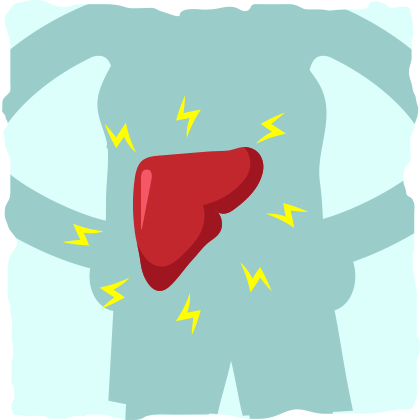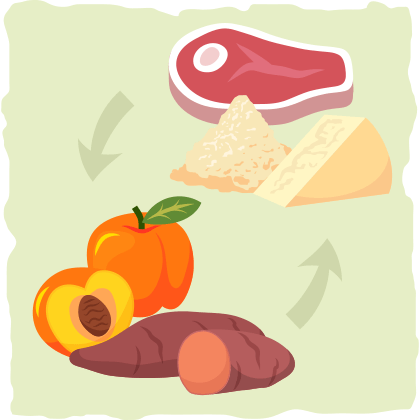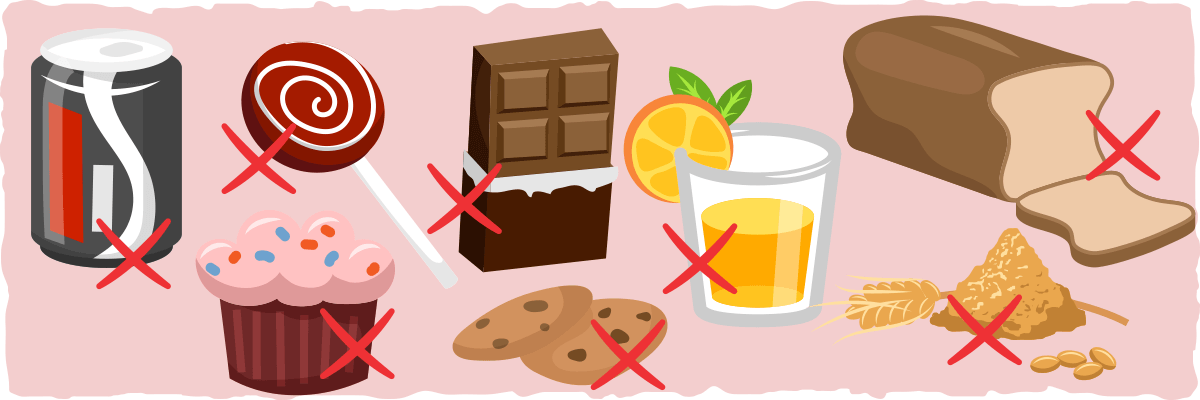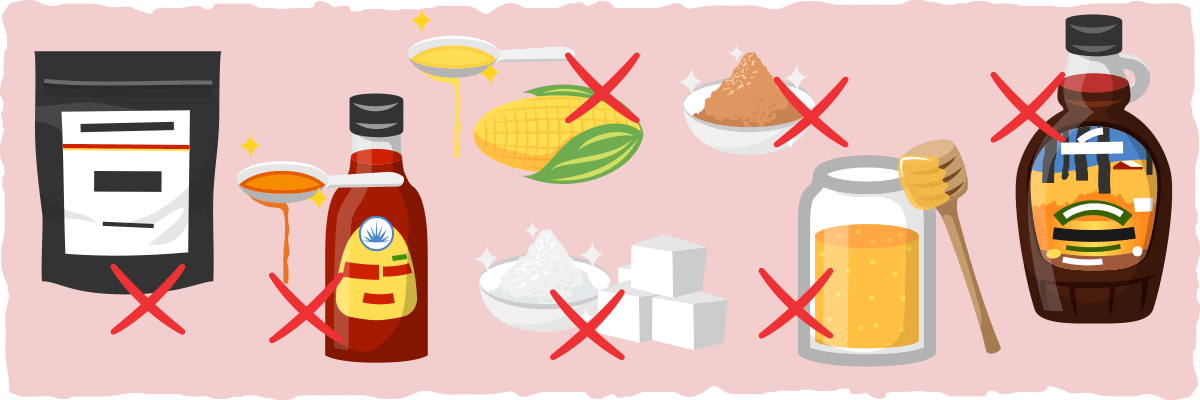Carbohydrates are generally avoided on a ketogenic diet, but they can be utilized with hard workouts that push your body.
If you sit all day and eat refined carbohydrates (like cookies, chips, and candy), your risk of heart disease and diabetes increases dramatically — bad. If you use carbohydrates as a way to fuel intense workouts or replenish your body’s depleted energy stores, then you can get the most out of your body without any negative side effects — good.
The same principle applies to the ketogenic diet. When used incorrectly, carbohydrates can take you out of ketosis and lead to fat gain. When used correctly, carbohydrates can be a tool that helps you get better results. If you’re interested in reading about refeeding diets combined with keto, feel free to read more on SKD, TKD, and CKD: The 3 Ketogenic Diets >
But before you pick up those sweet potatoes, we must first find out if consuming more carbs is right for you. If you are already on a standard ketogenic diet and not having problems with energy levels, consider sticking to it. If you are having problems growing strength and finishing workouts, a targeted or cyclical ketogenic diet may be a good fit.
A Ketogenic Diet With Carbs?
To follow a ketogenic diet properly you must restrict daily carbohydrates to around 20-30g of net carbs (net carbs are total dietary carbohydrates minus the total fiber). This simple rule should be followed by everyone who is on a ketogenic diet, but there is one exception — athletes.
By “athletes” I mean anyone who is doing high-intensity type training multiple times a week. Some examples of high-intensity type training are bodybuilding competitions, wrestling, circuit training (like CrossFit), and resistance training for low reps with weights above 80% one rep maximum.
During high-intensity activities, the body relies on glucose for fuel rather than fat. This happens because fat can only be used as energy when the cells have adequate oxygen.

Once the energy demands of the body exceed the amount of oxygen the cells have access to, the cells start burning glucose for fuel. How do you know when this happens? When you start huffing and puffing out of your mouth during the exercise. An indication that your body is burning glycogen rather than fat.
Glycogen is a complex sugar molecule that is stored in your muscles and liver as an energy source. During an extended period of time when carbohydrates are restricted (like during sleep, fasting, or the ketogenic diet), your body relies on stored glycogen to keep your blood sugar levels stable. When you are exercising, your body does the same thing. Glycogen stores, however, are not infinite. When stores run low, problems can arise.
The Ketogenic Conundrum
No food? No problem. Your body will use its stored glycogen. But what happens when you combine high-intensity training with a ketogenic diet? Glycogen depletion.
When glycogen is depleted, your body must rely on dietary protein and muscle protein for energy. This is why some studies have found that combining a ketogenic diet with resistance training doesn’t lead to as much muscle gain as expected.
In some cases, the ketogenic diet can even lead to muscle loss. A necessary side effect of a life-saving process called gluconeogenesis.
As long as you are eating consistently to your macros, you shouldn’t need to worry about this.

Gluconeogenesis — A Life-Saving “Magic Trick”

Some studies found that resistance trained individuals didn’t gain any muscle while combining a low carbohydrate diet with resistance training. What is responsible for this? A biological process that called gluconeogenesis.
When the body undergoes gluconeogenesis, it converts non-carbohydrates into a simple carbohydrate called glucose. One of the non-carbohydrates that the body can turn into glucose is protein. Some of this protein can come from muscle. This leads us to the conclusion that gluconeogenesis causes muscle loss — but this is only a theory. What does the research say?
One study on the difference between low-carb and high-carb diets made an interesting discovery. Researchers found that subjects on a low-carb diet used more protein to provide fuel during endurance exercise. Conversely, subjects on a high-carb diet relied on glycogen rather than protein. The researchers believe this means that “commencing endurance exercise in a glycogen-replete state may spare body protein by reducing net skeletal muscle and whole body protein degradation.”
In other words, people on a high-carb diet had enough glycogen to fuel their exercise. Thus high-carb dieters didn’t need to rely on muscle protein for fuel. Low-carb dieters, on the other hand, had to rely on protein for fuel because they didn’t have enough glycogen. This finding confirms that gluconeogenesis can lead to muscle loss during endurance exercise. This phenomenon also explains why some studies found low-carb dieters to gain less muscle mass than high-carb dieters during resistance training programs.
Should Athletes Avoid The Ketogenic Diet?
This doesn’t mean that a high-carbohydrate diet is the only answer for athletes, weekend warriors, and weight lifters. Some of the studies did not provide subjects with adequate protein intake. In studies that did ensure adequate protein intake, however, subjects on a ketogenic diet experienced muscle-sparing effects.
This finding highlights the importance of adequate protein intake regardless of the diet you are on. But how much protein is adequate? One study suggests that about 35% of your calories should come from protein to keep your body from breaking down muscle for energy.
However, one unsettling truth still looms over us. Diets that don’t restrict carbohydrates tend to increase muscle mass more than those that restrict carbohydrates, and they don’t come with the threat of muscle loss.

Does this mean that athletes, weekend warriors, and other high-intensity trainers should ditch the ketogenic diet in favor of a high-carbohydrate diet? Trick question. The answer is to use both.
The Answer — The Cyclical Ketogenic Diet
To gain muscle, improve health & mood, and increase performance, it is best to use the principles of both the high-carbohydrate diet and the ketogenic diet. This way you will gain the health benefits of ketosis and carbohydrates on the same diet. The best way to do this is by following a cyclical ketogenic diet.
The cyclical ketogenic diet devotes one to two full days of high carbohydrate consumption in order to fully refill muscle glycogen stores. The rest of the week is the standard ketogenic diet.
For the cyclical ketogenic diet to work, you must deplete your glycogen stores with training and get into ketosis before the carbohydrate refeeding days. This is an ideal dietary strategy for anyone who exercises at high intensities regularly, but it is not ideal for everyone. If you are new to exercising or only do endurance training, a targeted ketogenic diet may be a better option for you.

Another Possible Answer — The Targeted Ketogenic Diet
The targeted ketogenic diet is almost exactly the same as the standard ketogenic diet, but with one difference — targeted carbohydrate intake. About 30 minutes before you train, ingest 25-50 grams of simple carbohydrates (we recommend maple syrup). If you do that and eat a standard ketogenic diet the rest of the time, you’ve just implemented the targeted ketogenic diet. It’s that simple.
Using carbohydrates in this way will give your body the sugar it needs to spare glycogen, maintain blood sugar levels, and prevent muscle breakdown while you workout. However, this may only be helpful for exercise beginners and ultra-endurance athletes. People who exercise regularly at high-intensities only get minimal results from a targeted ketogenic diet.

Key Takeaways: Standard Keto vs. Cyclical Keto
Since high-intensity exercise requires glucose for fuel, a standard keto diet may not bode well for performance. This is why many athletes swear by keto diets with cyclic periods of higher carb intake (while others use precisely targeted carb consumption).
The best ketogenic diet for people who do high-intensity exercise regularly is the cyclical keto diet. This diet combines the benefits of ketosis and carbohydrates together in a way that allows regular high-intensity trainers to get the most out of their bodies and their training.
To implement the cyclical keto diet correctly, you must eat a high-carbohydrate diet 1-2 days a week to replenish your glycogen stores and follow a ketogenic diet on the remaining 5-6 days to deplete your glycogen stores. However, the carbohydrates that you eat are important as well.
What to Eat on a Cyclical Ketogenic Diet
When your goal is to deplete glycogen stores and get right back into ketosis, it is not a good idea to have simple carbohydrates like candy and sweets. This will lead to unhealthy increases in blood sugar, insulin, and inflammation.
One to two days of eating an abundance of simple carbohydrates will cause your body to store extra fat and negate the positive effects of the ketogenic diet. Eat complex carbohydrates instead.
What are Complex Carbohydrates?
Complex carbohydrates aren’t complex to understand, they are complex to digest. This means that complex carbohydrates take longer to digest than simple carbohydrates. Longer digestion leads to a steady increase in blood sugar levels that don’t cause unhealthy increases insulin. This leads to less fat gain, more glycogen repletion, and it’ll be easier to get back into ketosis.
Some examples of complex carbohydrates are:
- Whole unrefined grains
- Lentils & Legumes
- Quinoa
- Rice (brown, colored, and wild)
- Sweet Potatoes, peas, squash, and other starchy vegetables
- Fruit

Each one contains different amounts of fiber, vitamins, minerals, and phytonutrients (plant compounds) that improve your body’s ability to handle carbohydrates. For example, fiber and some specific phytonutrients slow down the absorption of sugar (from carbohydrates) into the bloodstream, while some vitamins, minerals, and other phytonutrients improve the ability for the body to use the carbohydrates. This makes complex carbohydrates ideal for our health whether we are on a cyclical ketogenic diet or not.
What to Avoid on a Cyclical Ketogenic Diet

Simple carbohydrates, on the other hand, have such a small amount of fiber, vitamins, minerals, and phytonutrients that the sugar is rapidly released into the bloodstream. This unhealthy increase in blood sugar causes damage to the cells that can lead to heart disease, diabetes, and cancer. The only way to prevent the negative effects of simple carbohydrates is to ingest a small amount of them 30 minutes before exercise (formerly known as the targeted ketogenic diet).
On a cyclical ketogenic diet, however, it is important to avoid all simple carbohydrates for best results.
Here’s an incomplete list of simple carbohydrates to avoid:
- Sugar-sweetened beverages (soda, Gatorade, Vitamin Water, etc.)
- Fruit juice
- White bread
- White flour
- Refined grains
- Cookies
- Cakes
- Candy
- Sweets

Many packaged foods that are thought of as health foods contain added sugars (simple carbohydrates) as well. If a food that you are thinking of consuming contains one of the added sugars listed below then it is best to avoid it (even if it is organic):
- Agave nectar
- Brown sugar
- Cane crystals
- Evaporated cane juice
- Fructose
- Malt syrup
- Fruit juice concentrates
- Molasses
- Maple syrup
- Cane sugar
- High-fructose corn syrup
- Sucrose
- Raw sugar
- Corn syrup
- Honey
- Crystalline fructose
- Invert sugar
- Dextrose
- Maltose
However, these lists don’t contain every simple carbohydrate source, so if you are unsure about a specific food, it is important to follow one general eating principle. Eat more whole plant foods and less processed & packaged foods. If you do this you will avoid almost all simple carbohydrates, and replete your glycogen stores in the healthiest way possible.
After your carbohydrate refeeding day(s), it is important to go back to a ketogenic diet that limits all carbohydrates. For an in-depth guide on what to eat on a standard ketogenic diet, check out our beginner’s guide. For more on how to implement the cyclical ketogenic diet, keep reading.
How to Start the Cyclical Ketogenic Diet
Now, let’s put everything we learned into a cyclical ketogenic diet plan. First, you must fit the cyclical ketogenic diet into your schedule. The standard format for a cyclical ketogenic diet is 5-6 days of ketogenic dieting and 1-2 days of high carbohydrate eating.
Others have also experimented with 2-week cycles — 10-12 days on the standard ketogenic diet and 3-4 days of carbohydrate refeeding. The 2 week split also brings good results, but it doesn’t fit around everyone’s schedules as neatly.
In order to figure out the ketogenic diet and carbohydrate refeeding cycle that works best for you, we must consider your workout schedule as well. One of the goals of your workout schedule is to ensure that you will be depleting your glycogen stores before carbohydrate refeeding.

A good example of a workout template is:
- Monday/Tuesday – Full body split. Monday could be legs and abs, and Tuesday could be chest, back, and arms.
- Friday – Full body, glycogen depletion workout.
The amount of training to completely deplete your glycogen is dependent on the amount of carbohydrates you had during refeeding. If low rep, heavy weights are being used, then 2-3 sets should be adequate. Conversely, if high rep, moderate weights are being used, you would need to do 5-6 sets.
If you don’t have weights, explosive exercises like short sprints, jump variations (squat jumps, lunge position jumps, etc.), and clap pushups can also help deplete your glycogen levels.
After your glycogen is fully depleted, you are ready to load up on complex carbohydrates for 1 to 2 days.
How Many Carbohydrates Should You Eat?
Your own experimentation is the best thing to recommend here, but here are some of our guidelines:
- First 24 hours of Carbohydrate Refeeding: Carbohydrates should make up 70% of your total caloric intake with 15% protein and 15% fats. Higher GI whole foods should be consumed. Some examples of healthy, high GI foods are potatoes, yams, carrots, bananas, pineapples, raisins, and rice.
- Second 24 hours of Carbohydrate Refeeding: 60% carbs, 25% protein, and 15% fats. Lower GI foods should be consumed. Some examples of lower GI foods are whole grains, peas, most berries (like blueberries and blackberries), lentils, and black beans.
Follow these guidelines and you will feel much better as your body recovers and replenishes its glycogen stores. However, eating this way will knock you out of ketosis.
How To Enter Ketosis After Carb Up

Once you finish your carbohydrate refeed, you must get back into ketosis as quickly as possible. The easiest and most foolproof method to do this? Simply follow these steps.
- Last Day of Carbohydrate Refeeding: Do not eat after 6 pm.
- Day 1 on the Standard Ketogenic Diet: Wake up and perform HIIT or intense weight training on an empty stomach. After the workout, begin a strict ketogenic diet with 0-2% carb intake.
- Day 2 on the Standard Ketogenic Diet: Wake up and perform MISS (medium intensity steady state) or medium intensity weight training on an empty stomach. Return to a normal ketogenic diet with 3-5% carb intake.
The longer you have been on a ketogenic diet, the quicker you’ll get back into ketosis. If you’ve been on the ketogenic diet for a year, you will find it much easier to re-enter ketosis than someone that has done it for a month.
Also, if you consume lower GI complex carbohydrates, it will be easier for you to re-enter ketosis (because of the reasons we discussed earlier in the article).
The more consistent you are with your cyclical ketogenic diet (proper carb ups, not cheating, etc.), the easier it will be to come back because your body will adapt more quickly each time.
Five Potential Benefits of the Cyclical Keto Diet
Though cyclical keto is popular as an athletic performance enhancer, athletes aren’t the only group who may benefit from keto and carb cycling. Here are the five unique advantages that a cyclic keto diet may provide us:
- Increase exercise volume and intensity. Whether you are an endurance athlete prepping for a marathon or a CrossFit enthusiast pushing for a personal record, having carbs on board can help boost strength and endurance.
- Boost exercise recovery and muscle growth with the anabolic power of insulin. Though chronically high insulin levels are unhealthy, a transient increase in this anabolic hormone can boost exercise recovery and muscle growth. Insulin does this by stimulating muscle protein synthesis and enhancing the anabolic effects of testosterone, growth hormone, and IGF-1 following a weight lifting session.
- Better gut health. Cyclical keto allows you to consume a wider variety of fiber-rich foods and resistant starches that help good gut bacteria to proliferate and improve your overall health.
- Keep your appetite and cravings under control. Though the keto diet can have appetite suppressing effects, some keto dieters will still struggle with hunger and cravings. These individuals may benefit from a carb cycle with slightly higher carb intake to make their keto lifestyle more sustainable. The theory here is that cycling carb consumption will stimulate more leptin release (i.e., our primary satiety hormone). This will in turn reduce appetite, curb cravings, and improve weight regulation.
- Make your keto lifestyle more sustainable. Restricting carb intake to maintain ketosis without any breaks can be hard and even impossible for some of us. Though following a strict keto can help you achieve rapid weight loss, it may not help you to sustain it. In most cases, it’s best to transition to a more flexible eating plan, whether it’s a cyclical diet with higher carb consumption or a less restrictive low carb diet.
FAQs about Cycling Carb Intake, Ketosis, and Weight Loss
Does the cyclical ketogenic diet work?
When implemented correctly, the cyclical keto diet can be effective for boosting athletic performance, exercise recovery, body composition transformation, and weight loss results.
However, it is crucial to follow the guidelines in this article because it is easy to overdo it during your higher carb consumption diet day(s).
Can you lose weight on cyclical keto?
Yes, you can lose weight with a cyclic ketogenic diet. However, it can be surprisingly easy to overdo it on high-carb day(s) and gain the weight back.
What is a keto cycling diet?
Cyclical keto and keto cycling can be used interchangeably. Other terms such as cyclic keto, cyclical ketosis, and carb cycling refer to a similar diet approach where you eat a strict keto diet followed by a higher carb diet.
How fast will you return to ketosis after your carb day(s)?
How fast your body produces ketones and enters ketosis will depend on several factors, including how long you’ve been on keto, what carb-rich foods you ate, and your physical activity levels.
If you’re already keto-adapted, consume healthy sources of carbs, and exercise at high intensities regularly, you’ll be in ketosis within the next 24 hours.
Putting It All Together: How to Start Cyclical Keto and Get Results

If you are on a standard ketogenic diet and do high-intensity exercise regularly, then you will benefit the most from a cyclical ketogenic diet. This diet combines the benefits of the ketogenic diet and higher carb diet together with little to no negative side effects.
To implement a cyclical ketogenic diet properly, you must first create a schedule. The most common format is 5-6 days of a ketogenic diet with 1-2 high-carb refeeding days. During the ketogenic diet phase of the cycle, do at least two medium to high-intensity workouts a week and one high-intensity, glycogen-depleting workout the day before carbohydrate refeeding.
During your carbohydrate refeed, it is best to consume complex carbohydrates from whole food sources. On the first day, we suggest getting at least 70% of your calories from carbohydrates sources like potatoes, yams, carrots, bananas, pineapples, raisins, and white rice. During the second day, it is best to decrease your carbohydrate intake by 10% and eat lower GI carbohydrates like whole grains, peas, blueberries, lentils, and black beans.
After you are finished replenishing your glycogen stores, the best way to get back into ketosis is to do a high-intensity workout on an empty stomach on the morning after your carb refeeding is over.
After the workout, restrict your carbs and continue with your standard ketogenic diet. To help you produce ketone bodies even more quickly, you can perform MISS (medium intensity steady state) or medium intensity weight training on an empty stomach on the second day of the ketogenic portion of your cyclical ketogenic diet.
That’s it. Restrict carbs and work out hard. Replenish and recover with carbs. A delicate balance of high-carbohydrate dieting and ketogenic dieting for better results.
However, if you do not do high-intensity exercise regularly, a standard ketogenic diet will likely provide the best results.
A Brief Overview of The Standard Ketogenic Diet
The low-carb portion of the cyclical ketogenic diet is identical to that of a standard ketogenic diet.
The nutrition is as follows:
- Calories for gaining mass: 18 calories per pound of body weight.
- Calories to lose weight: 12 calories per pound of body weight.
- Calories to maintain weight: 15-16 calories per pound of body weight.
- Carbohydrates: 30g or less per day. The fewer consumed, the faster you enter ketosis – this is more critical, as you only have 5-6 days of low carb.
- Protein: During the first 3 weeks eat around 1 gram per pound LEAN mass or 150g, whichever greater.
- Fats: Remainder of caloric needs.
Here is a brief list of what you should and should not eat on a standard ketogenic diet:
Do Not Eat:
- Grains – wheat, corn, rice, cereal, etc.
- Sugar – honey, agave, maple syrup, etc.
- Fruit – apples, bananas, oranges, etc.
- Tubers – potato, yams, etc.
Do Eat:
- Meats – fish, beef, lamb, poultry, eggs, etc.
- Leafy Greens – spinach, kale, etc.
- Above ground vegetables – broccoli, cauliflower, etc.
- High Fat Dairy – hard cheeses, high fat cream, butter, etc.
- Nuts and seeds – macadamias, walnuts, sunflower seeds, etc.
- Avocado and berries – raspberries, blackberries, and other low glycemic impact berries
- Sweeteners – stevia, erythritol, monk fruit, and other low-carb sweeteners
- Other fats – coconut oil, high-fat salad dressing, saturated fats, etc.
For more information on the standard ketogenic diet, check out our beginner’s guide.
Sources
- Nutrient timing revisited: is there a post-exercise anabolic window? — NCBI
- Carbohydrates for training and competition. — NCBI
- Effect of carbohydrate ingestion on glycogen resynthesis in human liver and skeletal muscle, measured by C MRS — APS
- Added Sugar in the Diet — Harvard
- Effect of glycogen availability on human skeletal muscle protein turnover during exercise and recovery — APS
- Very-low-carbohydrate diets and preservation of muscle mass — NCBI
- Ketogenic diet does not affect strength performance in elite artistic gymnasts — BioMed Central
- Resistance training in overweight women on a ketogenic diet conserved lean body mass while reducing body fat — BioMed Central
- Long-term Effects of a Very Low-Carbohydrate Diet and a Low-Fat Diet on Mood and Cognitive Function — The JAMA Network
- Relatively high-protein or ‘low-carb’ energy-restricted diets for body weight loss and body weight maintenance? — NCBI
- Effects of dietary carbohydrate restriction with high protein intake on protein metabolism and the somatotropic axis. — NCBI
- Integration of hormonal and nutrient signals that regulate leptin synthesis and secretion — NCBI
- High-Quality Carbohydrates and Physical Performance — NCBI
- Carbohydrates, Physical Training, and Sport Performance — Strength & Conditioning Journal